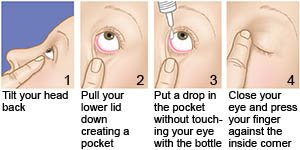How to Use Eye Drops
Medically reviewed by Drugs.com. Last updated on Apr 6, 2025.
How do I use eye drops properly?
Read the instructions carefully before you use eye drops. Store eye drops at room temperature and away from heat, moisture, and direct light. Do not use the drops if they change color or turn cloudy. Do not use the drops if they have small bits floating in them. Wash your hands before and after you put in eye drops.
- Gently shake the bottle.
- Do not touch the tip of the bottle to your eye. Germs from your eye can spread to the medicine bottle.
- Tilt your head back and pull down your lower eyelid with your index finger.
- Gently squeeze the bottle to drop the correct number of drops into your eye. Wait at least 5 minutes between each drop.
- Close your eyes. Press your index finger against the inside corner of your eye next to your nose for 1 minute.
- If you use more than one kind of drop, wait 10 to 15 minutes before you use the second one.
- Gently wipe away any extra liquid with a tissue.
- Replace the cap on the bottle.
- Do not rub your eyes.
 |
Drugs used to treat this and similar conditions
Combigan
Combigan (brimonidine and timolol) is used to treat glaucoma or ocular hypertension. Includes ...
Lotemax
Lotemax and Lotemax SM (loteprednol etabonate) are corticosteroid medications used to help treat ...
Omvoh
Omvoh is used to treat moderate to severe ulcerative colitis or Crohn's disease in adults. This ...
Blephamide
Blephamide is used for blepharitis, conjunctivitis, bacterial, keratitis, keratoconjunctivitis, uveitis
Valacyclovir
Valacyclovir is used to treat genital herpes, cold sores, shingles, and chicken pox. Learn about ...
Acyclovir
Acyclovir is an antiviral drug. It slows the growth and spread of the herpes virus. It will not ...
Trifluridine ophthalmic
Trifluridine ophthalmic is used for herpetic keratitis
Triamcinolone topical
Triamcinolone Acetonide Cream is used for psoriasis, eczema, dermatitis, rashes, and other itchy or ...
When should I contact my healthcare provider?
- You have eye pain or watering.
- You have changes in your vision.
- Your eyes are red, swollen, or draining pus.
- You develop a rash or hives.
- You have questions or concerns about your condition or care.
Care Agreement
You have the right to help plan your care. Learn about your health condition and how it may be treated. Discuss treatment options with your healthcare providers to decide what care you want to receive. You always have the right to refuse treatment. The above information is an educational aid only. It is not intended as medical advice for individual conditions or treatments. Talk to your doctor, nurse or pharmacist before following any medical regimen to see if it is safe and effective for you.© Copyright Merative 2025 Information is for End User's use only and may not be sold, redistributed or otherwise used for commercial purposes.
Further information
Always consult your healthcare provider to ensure the information displayed on this page applies to your personal circumstances.
